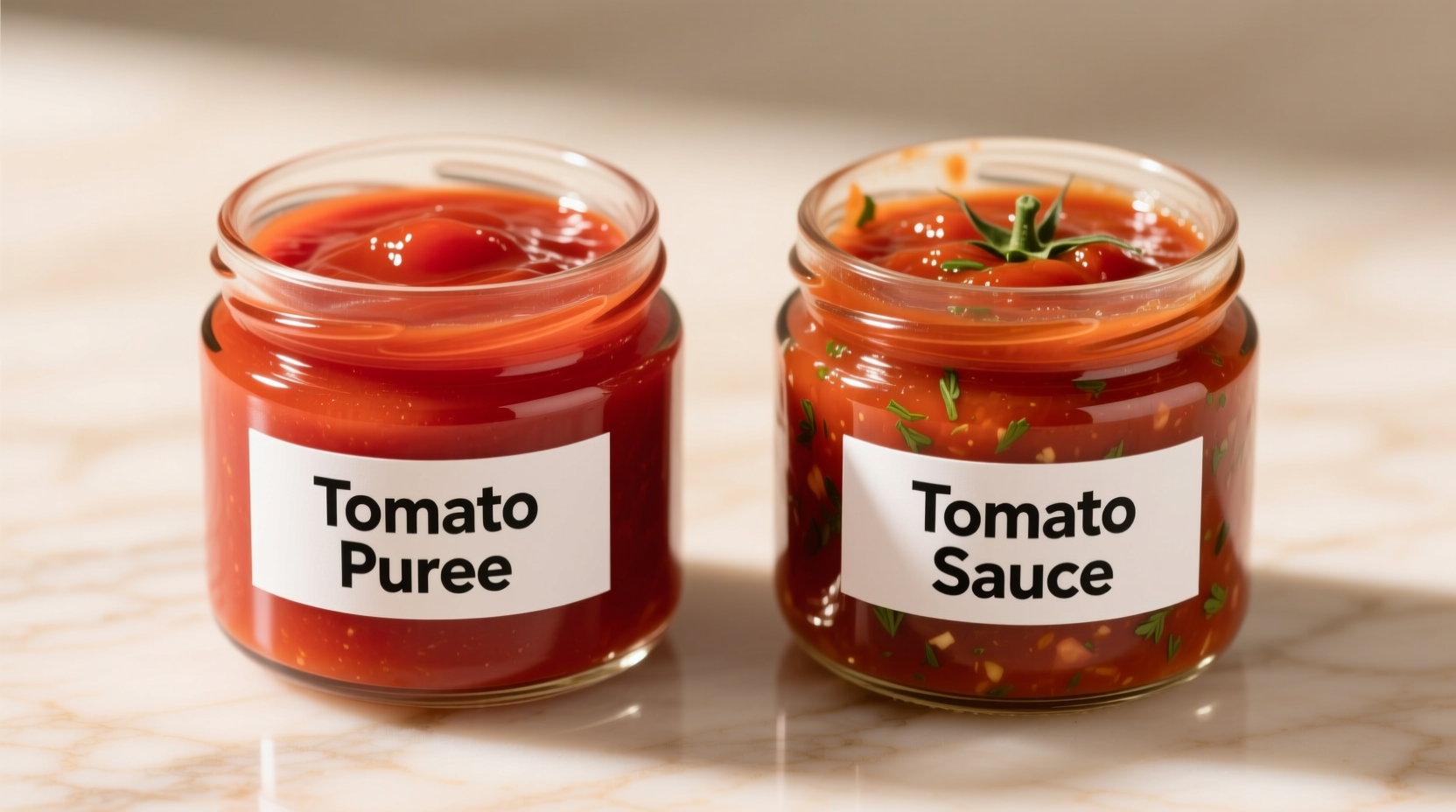Clearing Up the Tomato Product Confusion
Many home cooks reach for "tomato sauce" when a recipe calls for "tomato puree" (or vice versa), only to end up with dishes that taste too sweet, too salty, or have the wrong consistency. This common kitchen mistake happens because grocery stores often place these products side by side with similar packaging, creating understandable confusion.
Tomato Puree vs. Tomato Sauce: The Essential Differences
The fundamental distinction lies in composition and culinary purpose. Let's break down exactly what separates these two pantry staples:
| Characteristic | Tomato Puree | Tomato Sauce |
|---|---|---|
| Base Ingredients | 100% tomatoes (cooked and strained) | Tomatoes plus seasonings, sugar, salt, and sometimes vegetables |
| Texture | Thick, smooth concentrate (similar to paste but less dense) | Thinner, more liquid consistency |
| Flavor Profile | Intense tomato flavor, slightly acidic | Balanced with added sugar, herbs, and seasonings |
| Added Ingredients | None (by USDA standards) | Sugar, salt, citric acid, onions, garlic, herbs |
| Typical Use | As a base for sauces, soups, and stews | Ready-to-use in pasta dishes, pizza, or as is |
Why the Distinction Matters in Your Cooking
According to the USDA's standards for tomato products, tomato puree must contain between 8-24% tomato solids with no added ingredients, while tomato sauce typically contains 6-8% solids plus various seasonings. This seemingly small difference dramatically impacts your final dish.
Professional chefs at the Culinary Institute of America emphasize that substituting one for the other without adjustments often leads to:
- Overly sweet dishes when using sauce instead of puree
- Excessively acidic results when using puree instead of sauce
- Incorrect sauce consistency affecting texture and mouthfeel
- Unbalanced flavor profiles that don't match recipe intentions
When to Use Each Product: Practical Guidance
Understanding the appropriate application prevents culinary disasters. Here's how professional cooks approach these ingredients:
Reach for Tomato Puree When:
- You're building a sauce from scratch and need a concentrated tomato base
- Creating soups or stews where you control all seasoning
- Need to thicken a dish without adding extra flavors
- Working with recipes that specify "tomato puree" or "tomato passata"
Choose Tomato Sauce When:
- You want a ready-to-use base for quick pasta dishes
- Preparing pizza with minimal additional ingredients
- Following recipes specifically calling for "tomato sauce"
- Creating dishes where the additional seasonings complement your recipe
Smart Substitution Strategies
When you only have one product but need the other, these adjustments maintain recipe integrity:
Using Tomato Sauce Instead of Puree:
For every cup of tomato puree required, use 1¼ cups of tomato sauce and reduce added sugar by 1 tablespoon. Simmer uncovered for 10-15 minutes to thicken to the proper consistency.
Using Puree Instead of Sauce:
For each cup of tomato sauce needed, combine ½ cup tomato puree with ½ cup water. Add 1 teaspoon sugar, ¼ teaspoon salt, and ½ teaspoon dried herbs (like oregano or basil) to approximate standard tomato sauce flavor.
Avoid These Common Tomato Product Mistakes
Based on analysis of cooking forums and culinary school feedback, these errors happen most frequently:
- Mistake: Using tomato sauce in place of puree without adjustments
Solution: Always reduce liquid content and adjust seasonings when substituting - Mistake: Confusing tomato puree with tomato paste
Solution: Remember paste is significantly thicker and more concentrated than puree - Mistake: Not checking ingredient labels for added preservatives
Solution: Compare brands for minimal ingredient lists when possible

Regional Variations to Consider
The naming conventions vary internationally, adding to the confusion. In the UK and Australia, "tomato passata" refers to what Americans call tomato puree. Meanwhile, Italian "sugo" typically contains more ingredients than American "tomato sauce." When following international recipes, always check the ingredient list rather than relying solely on the product name.
Storage and Shelf Life Differences
Both products share similar storage requirements once opened (refrigerate and use within 5-7 days), but their shelf stability differs:
- Unopened tomato puree: 18-24 months in pantry
- Unopened tomato sauce: 12-18 months due to additional ingredients
- Freezing both extends usability to 6 months (puree freezes better than sauce)











 浙公网安备
33010002000092号
浙公网安备
33010002000092号 浙B2-20120091-4
浙B2-20120091-4